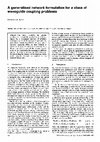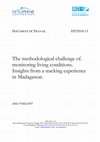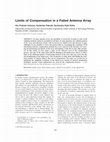Papers by Sachendra Sinha
2009 World Congress on Nature & Biologically Inspired Computing (NaBIC), 2009
... 8 9 10 11 12 13 14 15 16 17 18 Frequency (GHz) S11 (d B) 1112 2009 World Congress on Nature &... more ... 8 9 10 11 12 13 14 15 16 17 18 Frequency (GHz) S11 (d B) 1112 2009 World Congress on Nature & Biologically Inspired Computing (NaBIC 2009) Page 3. ... S11 (d B) 2009 World Congress on Nature & Biologically Inspired Computing (NaBIC 2009) 1113 Page 4. ...
Journal of Electromagnetic Waves and Applications
ABSTRACT

IETE Technical Review, 2001
In this paper, the general problem of electromagnetic coupling between two dissimilar regions, bo... more In this paper, the general problem of electromagnetic coupling between two dissimilar regions, both open at infinity, via an aperture of arbitrary shape is considered. The aperture is assumed to be located in a conducting screen of infinitesimal thickness. The analysis is based on the “generalised network formulation” for aperture problems. Field equivalence principle is first used to divide the problem into two parts. Next, boundary conditions are invoked to obtain a magnetic field integral equation (MFIE) which is then solved using the method of moments (MOM). Triangular patches, with appropriately defined basis functions, are used to model the arbitrarily shaped aperture. This leads to a matrix equation whose solution requires the evaluation of integrals with bounded and unbounded kernels over a triangular domain. Representative results are given for rectangular, circular, elliptic, diamond-shaped, cross-shaped and H-shaped apertures.
IETE Journal of Research, 2002
A moment-method analysis of waveguide-backed apertures of arbitrary shape is presented. The “gene... more A moment-method analysis of waveguide-backed apertures of arbitrary shape is presented. The “generalized network formulation” for aperture problems[1] has been used for formulating the problem in terms of an operator equation. Triangular patch modeling, with suitably defined basis functions, is utilized for the solution of the operator equation. Representative aperture shapes considered include rectangular, circular, elliptic, diamond, and H. Numerical results are presented for equivalent surface magnetic current, equivalent aperture admittance and antenna power gain patterns.

IEE Proceedings H Microwaves, Antennas and Propagation, 1987
The paper considers the general problem of a waveguide coupled to an arbitrary region via a recta... more The paper considers the general problem of a waveguide coupled to an arbitrary region via a rectangular aperture of arbitrary dimensions in the thick common broad wall. An equivalence theorem is utilized to set up a pair of operator equations which are then reduced to matrix form using the method of moments. It is shown that only a part of the moment matrix needs to be recalculated for coupling to different regions. The basic procedure has been illustrated by considering the example of two identical waveguides coupled through an aperture in the common broad wall. further, a large number of subsections being needed to reasonably approximate the aperture field distribution. In order to reduce the computational effort, Lyon and Sangster [13] have utilised sinusoidal basis functions in their study of radiating slots. However, in both the methods the problems of longitudinal and transverse slots have to be analysed separately and, also, the effect of finite slot width is ignored. In this paper, we present an alternative moment procedure which is based upon the generalised network formulation for aperture problems [14] and can deal with slots of arbitrary dimensions. It is suggested that this formulation can form a basis for the generation of a common computer code to analyse a broad catagory of waveguide coupling problems.
Springer Series in Optical Sciences, 2014
Introduction.- Method of Moment Formulation of Coupling through Apertures.- Fractal Frequency Sel... more Introduction.- Method of Moment Formulation of Coupling through Apertures.- Fractal Frequency Selective Diaphragms in Rectangular Waveguide.- Electromagnetic Transmission through Fractal Apertures in Conducting Screen.- Radiation from Rectangular Waveguide-Fed Fractal Aperture Antennas.- Investigations on Cavity-Backed Fractal Aperture Antennas.- Conclusions and Future Work.
2012 Loughborough Antennas & Propagation Conference (LAPC), 2012
ABSTRACT

IETE Journal of Research, 2002
In this paper, measurement and simulation results for modeling of wave propagation in an indoor e... more In this paper, measurement and simulation results for modeling of wave propagation in an indoor environment are presented. Complex wideband frequency responses centered at frequency 3.6 GHz have been measured and approximation to the impulse response of the channel is obtained from the Inverse Fourier Transform of the frequency response. Narrowband measurements were conducted at 3.3, 3.6 and 3.9 GHz to compute the Path Loss Law. All the experiments were performed in a triple-storied office building. A ray tracing technique has been used to simulate the wave propagation in the building. Ray tubes have been used to model the wave propagation and all the reflected and transmitted ray tubes from interfaces have been included. A program has been developed in MATLAB that can be used to simulate wave propagation in large 3D buildings. Simulation results have been verified by comparing them with measured data.
Antennas and Propagation Society International Symposium, 2008
Particle swarm optimization (PSO) procedure has been applied to find out a compensation for degra... more Particle swarm optimization (PSO) procedure has been applied to find out a compensation for degraded pattern of a failed antenna array by amplitude only perturbation of few of the unfailed elements. The optimization technique finds the optimum amplitude levels of some of the unfailed elements in the array, so that the compensated pattern will match with the pattern of the
Proceedings of the 2012 IEEE International Symposium on Antennas and Propagation, 2012
A Novel design approach is proposed for designing customized fractal frequency selective surfaces... more A Novel design approach is proposed for designing customized fractal frequency selective surfaces (FSS) by combining the merits of Artificial Neural Network (ANN) and Particle Swarm Optimization (PSO). The trained ANN developed for analysis of fractal FSS is embedded in the optimization loop of PSO to find out the design dimensions of the unit cell of fractal FSS for user-defined stop band frequencies. The developed methodology is tested with Sierpinski carpet as the candidate structure and the effectiveness of the developed approach is confirmed by the simulation result. I.
2011 National Conference on Communications (NCC), 2011
Creation of nulls in specified directions is desirable in order to reduce the effect of interferi... more Creation of nulls in specified directions is desirable in order to reduce the effect of interfering signals. But in large antenna arrays there possibility of getting a fault from some of the radiating elements can not be denied. In such a situation, the pattern of the array get distorted mostly with an increasing sidelobe level and removable of the null from its desired position. In this paper a method using particle swarm optimization(PSO) is developed to maintain the null position of the failed antenna array.

2011 IEEE International Conference on Microwaves, Communications, Antennas and Electronic Systems (COMCAS 2011), 2011
Most longitudinal surveys recontact households only if they are still living in the same dwelling... more Most longitudinal surveys recontact households only if they are still living in the same dwelling, producing very high attrition rates, especially in developing countries where rural-urban migration is prevalent. In this paper, we discuss the implications of the various follow-up rules used in longitudinal surveys in the light of an original tracking survey from Madagascar. This survey attempted in 2005 to search and interview all individuals who were living in the village of Bepako in 1995, the baseline year of a yearly survey, the Rural Observatories. The tracking survey yielded an individual recontact rate of 78.8%, more than halving attrition compared to a standard dwelling-based follow-up rule. The tracking reveals a very high rate of out-migration (38.8%) and household break-ups, as three quarters of recontacted households had divided between 1995 and 2005. The average income growth of the sample over the period increases by 28 percentage points when follow-up is extended to those who moved out of their household or village, suggesting that dwelling-based panels give a partial view of the welfare dynamics of the baseline sample. A higher baseline income per capita is associated with a higher probability of staying in Bepako and of being found in the tracking if one moved out. The hardest people to find are the poorest and most isolated. Special attention should be paid to collecting data that enable the identification and follow-up of individuals without which attrition is likely to remain a source of bias even after a tracking procedure is carried out.

International Journal of RF and Microwave Computer-Aided Engineering, 2014
In large antenna arrays, the possibility of occurrence of faults in some of the radiating element... more In large antenna arrays, the possibility of occurrence of faults in some of the radiating elements cannot be precluded at all times. In such situations, the radiation pattern of the array gets distorted, mostly with an increase in sidelobe level and decrease in gain. Although it is not possible to restore the pattern fully by rearranging the excitations of the functioning elements, compensation methods have been reported in the literature for restoring one performance parameter of the array and making a trade-off on some other parameter. In this article, we have made a study on the tolerance level of this compensation process. One part of the study deals with the thinning in the failed array, that is, to find a limit on the minimum number of functioning elements of the array that can restore the digital beamforming of the failed array. The second part of study deals with finding the maximum number of element failures that can be compensated. The study was carried out by optimizing the amplitude excitations of the failed array. Instead of classical optimization techniques, particle swarm optimization was used for the compensation process. V C 2014
International Journal of RF and Microwave Computer-Aided Engineering, 2010
Page 1. Investigations on Fractal Frequency Selective Diaphragms in Rectangular Waveguide Basudeb... more Page 1. Investigations on Fractal Frequency Selective Diaphragms in Rectangular Waveguide Basudeb Ghosh, Sachendra N. Sinha, MV Kartikeyan Department of Electronics and Computer Engineering, Indian Institute of Technology Roorkee, Roorkee 247667, India ...
International Journal of Machine Learning and Cybernetics, 2012
Machine learning approaches, viz. particle swarm optimization in conjunction with neural networks... more Machine learning approaches, viz. particle swarm optimization in conjunction with neural networks have been used to develop a user friendly tool to design custom-made stacked patch antennas in the entire X-Ku band for satellite communication application. The role of the neural network is to develop a black-box model to relate the frequencies of operation of the antenna with its dimensional parameters. This trained neural network was embedded in the loop of a particle swarm optimizer to decide the design dimensions required for specific user defined frequencies. The effectiveness and accuracy of the developed model are verified by simulations and experimental measurements.
IETE Journal of Research, 2008
This paper presents the experimental evaluation of the ′Specific Absorption Rate′ (SAR) reduction... more This paper presents the experimental evaluation of the ′Specific Absorption Rate′ (SAR) reduction in a human head due to radio frequency (RF) shields attached to a mobile handset. Shields of various shapes and sizes were made from a nickel-zinc spinel ferrite. The human head ...
IEEE Transactions on Antennas and Propagation, 2010
AbstractWe investigate the properties of fractal apertures fed by a rect-angular waveguide. The ... more AbstractWe investigate the properties of fractal apertures fed by a rect-angular waveguide. The self-similarity and space-filling properties of frac-tals have been exploited to achieve multi-band radiation. Some self-affine fractal geometries, suitable for ...
IEEE Antennas and Propagation Magazine, 2011
We present a design procedure for making custom-made fractal antennas using artificial neural net... more We present a design procedure for making custom-made fractal antennas using artificial neural networks (ANN) and the Particle-Swarm Optim ization (PSO) technique. The role of the artificial neural network is to form a mapping between the design parameters of the fractal antenna and its operational frequencies. The role of Particle-Swarm Optim ization is to find the shape of the antenna for the required user-defi ned frequencies, using the previously trained artificial neural network. Sierpinski gasket and Koch monopole antennas were taken as the candidate antennas, and the effectiveness of the developed approach was confirmed by simulation and experimental results. Antenna shapes at various user defi ned freq uencies were designed and tested.
Bulletin of Materials Science, 2008
This paper deals with the development and characterization of nickel-zinc spinel ferrite (Ni (1-δ... more This paper deals with the development and characterization of nickel-zinc spinel ferrite (Ni (1-δ) Zn δ Fe 2 O 4) for microwave absorption at 2⋅4 GHz (ISM band). The ferrite powder was prepared by dry attrition and sintering process. Complex permittivity and permeability of the prepared sample have been determined by measuring its scattering parameters with the help of a vector network analyser. The measured parameters have been used to determine its wave absorption properties over a frequency range 2⋅1-2⋅6 GHz.
Progress In Electromagnetics Research C, 2009
This paper investigates the properties of probe fed cavitybacked fractal aperture antennas. The p... more This paper investigates the properties of probe fed cavitybacked fractal aperture antennas. The problem is formulated using the finite element-boundary integral (FE-BI) method in which the field inside the cavity is formulated using the finite element method, and the mesh is truncated at cavity aperture surface using the boundary integral method. Several dual-band cavity-backed fractal aperture antennas based on Sierpinski gasket, Sierpinski carpet, plus shape fractal and Minkowski fractal are investigated. The numerical results obtained from the FE-BI code have been validated with simulations on HFSS.
Uploads
Papers by Sachendra Sinha